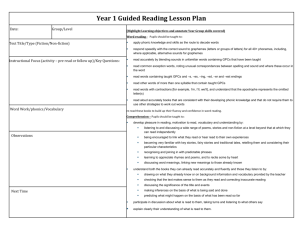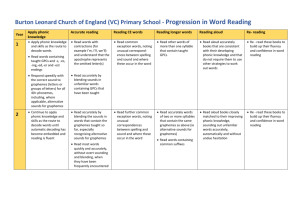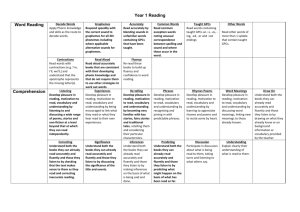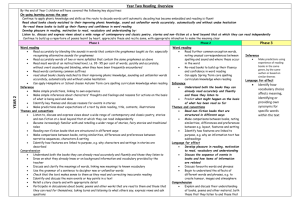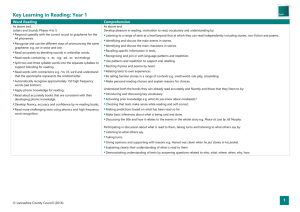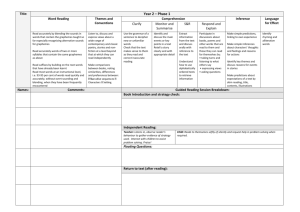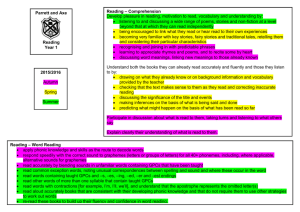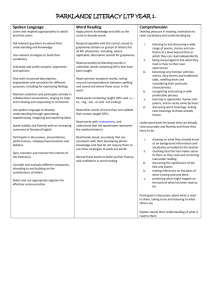Essential Opportunities Reading Milestone 1 • Listen to traditional
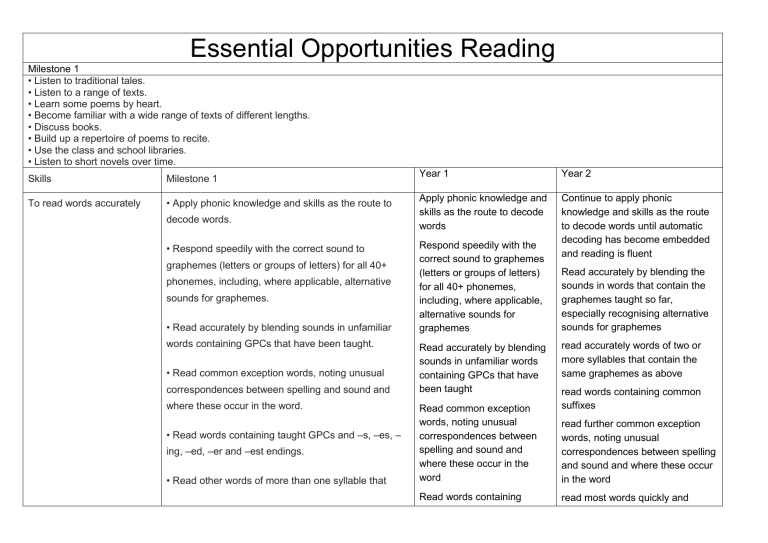
Essential Opportunities Reading
Milestone 1
• Listen to traditional tales.
• Listen to a range of texts.
• Learn some poems by heart.
• Become familiar with a wide range of texts of different lengths.
• Discuss books.
• Build up a repertoire of poems to recite.
• Use the class and school libraries.
• Listen to short novels over time.
Year 1
Skills Milestone 1
Year 2
To read words accurately • Apply phonic knowledge and skills as the route to decode words.
• Respond speedily with the correct sound to graphemes (letters or groups of letters) for all 40+ phonemes, including, where applicable, alternative sounds for graphemes.
• Read accurately by blending sounds in unfamiliar words containing GPCs that have been taught.
• Read common exception words, noting unusual correspondences between spelling and sound and where these occur in the word.
• Read words containing taught GPCs and –s, –es, – ing, –ed, –er and –est endings.
• Read other words of more than one syllable that
Apply phonic knowledge and skills as the route to decode words
Respond speedily with the correct sound to graphemes
(letters or groups of letters) for all 40+ phonemes, including, where applicable, alternative sounds for graphemes
Read accurately by blending sounds in unfamiliar words containing GPCs that have been taught
Read common exception words, noting unusual correspondences between spelling and sound and where these occur in the word
Read words containing
Continue to apply phonic knowledge and skills as the route to decode words until automatic decoding has become embedded and reading is fluent
Read accurately by blending the sounds in words that contain the graphemes taught so far, especially recognising alternative sounds for graphemes read accurately words of two or more syllables that contain the same graphemes as above read words containing common suffixes read further common exception words, noting unusual correspondences between spelling and sound and where these occur in the word read most words quickly and
contain taught GPCs.
• Read words with contractions (for example, I’m, I’ll, we’ll) and understand that the apostrophe represents the omitted letter(s). taught GPCs and –s, –es, – ing, –ed, –er and –est endings
Read other words of more than one syllable that contain taught GPCs accurately, without overt sounding and blending, when they have been frequently encountered
• Read aloud accurately books that are consistent with phonic knowledge and that do not require other strategies to work out words.
Read words with contractions
[for example, I’m, I’ll, we’ll], and understand that the apostrophe represents the omitted letter(s)
• Re-read these books to build up fluency and confidence in word reading.
• Read accurately by blending the sounds in words that contain the graphemes taught so far, especially recognising alternative sounds for graphemes.
Read aloud accurately books that are consistent with their developing phonic knowledge and that do not require them to use other strategies to work out words
• Read accurately words of two or more syllables that contain the same graphemes as above.
Re-read books to build up their fluency and confidence in word reading.
• Read words containing common suffixes.
• Read common exception words, noting unusual correspondences between spelling and sound and where these occur in the word.
• Read most words quickly and accurately, without overt sounding and blending, when they have been frequently encountered.
To understand texts
• Read aloud books closely matched to their improving phonic knowledge, sounding out unfamiliar words accurately, automatically and without undue hesitation.
• Re-read books to build up fluency and confidence in word reading.
• Discuss events.
• Predict events.
• Link reading to own experience.
• Join in with stories or poems.
• Check that reading makes sense and self-correct.
• Infer what characters are like from actions.
• Ask and answer questions about texts.
• Discuss favourite words and phrases.
• Listen to and discuss a wide range of texts.
• Recognise and join in with (including roleplay) recurring language.
• Explain and discuss understanding of texts. develop pleasure in reading, motivation to read, vocabulary and understanding understand both the books they can already read accurately and fluently and those they listen to
Participate in discussion about what is read to them, taking turns and listening to what others say
Explain clearly their understanding of what is read to them.
Develop pleasure in reading, motivation to read, vocabulary and understanding by: listening to, discussing and expressing views about a wide range of contemporary and classic poetry, stories and non-fiction at a level beyond that at which they can read independently discussing the sequence of events in books and how items of information are related becoming increasingly familiar with and retelling a wider range of stories, fairy stories and traditional tales being introduced to non-fiction books that are structured in different ways recognising simple recurring literary language in stories and poetry discussing and clarifying the meanings of words, linking new meanings to known vocabulary
• Discuss the significance of the title and events.
• Make inferences on the basis of what is being said and done. discussing their favourite words and phrases continuing to build up a repertoire of poems learnt by heart, appreciating these and reciting some, with appropriate intonation to make the meaning clear understand both the books that they can already read accurately and fluently and those that they listen to by: drawing on what they already know or on background information and vocabulary provided by the teacher checking that the text makes sense to them as they read and correcting inaccurate reading making inferences on the basis of what is being said and done answering and asking questions predicting what might happen on the basis of what has been read so far
Participate in discussion about books, poems and other works that are read to them and those that they can read for themselves, taking turns and listening to what others say
Explain and discuss their understanding of books, poems and other material, both those that
they listen to and those that they read for themselves.
